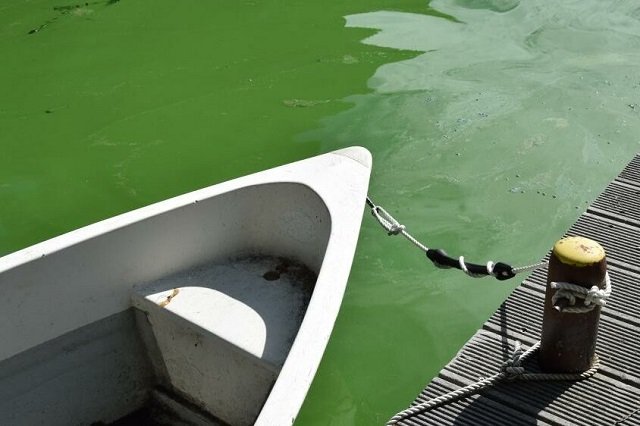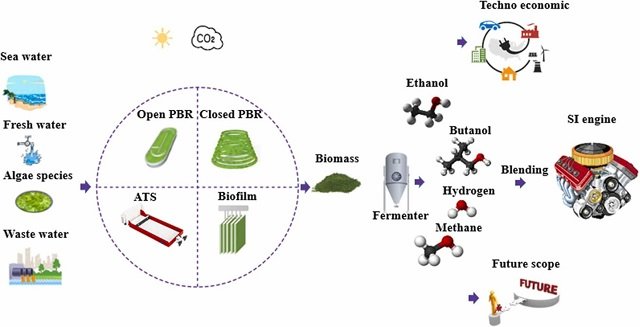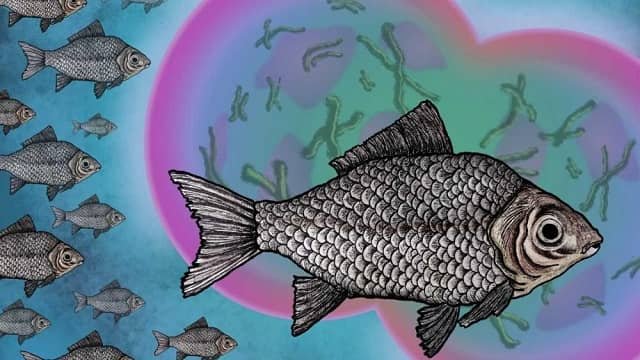
by Forschungsverbund Berlin e.V. (FVB)
Mass developments of cyanobacteria, so-called blue-green algae blooms, repeatedly threaten the quality of water bodies and drinking water resources worldwide.
Cyanobacteria are considered to be heat-loving, and massive algal blooms are reported mainly in summer, when monitoring is particularly close. Now, an international research network involving IGB has shown that cyanobacterial blooms can also occur at colder temperatures – even under ice. If the algal blooms go unnoticed, there are risks to drinking water production. The study was published in the journal Limnology and Oceanography Letters.
Cyanobacteria – also known as blue-green algae – can produce toxins and deprive water of oxygen and aquatic plants of light for photosynthesis. Cyanobacterial blooms thus threaten aquatic ecosystems and their living organisms, as well as drinking water resources and bathing waters.
These blooms have been the focus of attention, especially in the context of climate change, because warmer water temperatures above 25 degrees Celsius favor the growth of Cyanobacteria – that has been the scientific tenor so far. Now, a research team from the international Global Lake Ecosystem Observatory Network (GLEON) has shown that cyanobacterial blooms can also occur in lakes at relatively low water temperatures <15 degrees Celsius – even under a layer of ice. To do this, the researchers used existing scientific data, including that collected by citizen scientists via an app or with the help of microscope sets.
Dr. Kaitlin Reinl, principal investigator of the study and research coordinator at the U.S. Lake Superior National Estuarine Research Reserve said “Cyanobacterial blooms are complex and a major challenge. Current thinking regarding blooms is that they like it hot, and in many cases, they do. However, we’ve been seeing more evidence that blooms can also occur when it’s cold. When this happens, we feel blind-sided because it goes against what we’ve previously heard. This paper highlights the need for understanding cold-water cyanobacterial blooms. It is a reminder that lakes can be very active when temperatures cool.”
Cold or warm waters – same types of waters and affected by same cyanobacterial species
- 1 Cold or warm waters – same types of waters and affected by same cyanobacterial species
- 2 Three types of cyanobacterial blooms in cold water
- 3 Strong storms in climate change could mix up algal blooms during cold temperatures
- 4 Unnoticed algal blooms in deeper water layers can pollute drinking water
- 5 Entradas relacionadas:
Cyanobacterial blooms are most common in nutrient-rich, “over-fertilized,” waters – whether in cold or warm environments. Often it is the same species of Cyanobacteria that form mass blooms in both warm and cold water. However, these exhibit certain characteristics. For example, they show broad temperature tolerance and have developed special survival strategies for cold temperatures –such as cold shock and freeze protection proteins or a cold-resistant cell wall made of unsaturated fatty acids. “Some filamentous cyanobacteria species are highly abundant in winter even during ice-covered periods, due to their ability to adapt to low-light conditions and low temperatures. By surviving extended periods of reduced light, these taxa have a competitive advantage when light returns in spring”, explained IGB researcher Dr. Stella Berger, co-author of the study.
Activation from resting stages can also be a trigger for cyanobacterial blooms. In fact, some species form dormant stages that lie at the bottom of the water and awaken as soon as environmental conditions change – even at colder temperatures. For example, it is known about Microcystis aeruginosa that bottom-dwelling bacteria activate the resting stages of these cyanobacteria.
Three types of cyanobacterial blooms in cold water
The authors classified three types of cyanobacterial blooms in cold water, depending on how they occur. First: surface blooms initiated and persisting at cold water temperatures. Second, cyanobacterial blooms that occur in the so-called thermocline, where two layers of water with a steep temperature gradient overlie each other and are brought to the surface by physical processes. And third, algal blooms that begin at warmer temperatures and persist at colder temperatures.
Stay Always Informed
Join our communities to instantly receive the most important news, reports, and analysis from the aquaculture industry.
Strong storms in climate change could mix up algal blooms during cold temperatures
The second type of cyanobacterial blooms, which occur in the thermocline, go undetected for now because they occur in the deeper layers of water. Storms can bring these to the surface. “We were able to observe this in Lake Stechlin a few years ago. A strong storm caused the water column to circulate, Cyanobacteria came to the surface in masses and deteriorated the water quality of the lake for several weeks. As strong storms increase due to climate change, such events will certainly occur more frequently,” explained IGB researcher Dr. Mina Bizic, co-author of the study. This phenomenon has also been described for Lake Zürich or small glacial lakes and reservoirs.
Unnoticed algal blooms in deeper water layers can pollute drinking water
But even if the cyanobacterial blooms remain in the deeper layers of the lake, they can be dangerous for the ecosystem and health. For example, drinking water intakes are often located far below the water surface, and unnoticed cyanobacterial blooms can then contaminate the extracted drinking water with toxins. “The study shows that the ‘cyanobacterial blooms like it warm’ paradigm needs to be broken. For water monitoring and management, this means that sampling should be extended to the cold seasons, and that we need to keep an eye on algal blooms in the deeper water layers that can be harmful for drinking water”, summarized co-author and IGB researcher Prof. Dr. Hans-Peter Grossart.
Contact
Leibniz Institute of Freshwater Ecology and Inland Fisheries (IGB)
Plankton and Microbial Ecology
Prof. Dr. Hans-Peter Grossart
Phone +49 33082 699-91
Email hgrossartigb-berlin.de
Dr. Mina Bizic
Email mbizicigb-berlin.de
Dr. Stella A. Berger
Email stella.bergerigb-berlin.de
Reference (open access)
Reinl, K.L., Harris, T.D., North, R.L., Almela, P., Berger, S.A., Bizic, M., Burnet, S.H., Grossart, H.-P., Ibelings, B.W., Jakobsson, E., Knoll, L.B., Lafrancois, B.M., McElarney, Y., Morales-Williams, A.M., Obertegger, U., Ogashawara, I., Paule-Mercado, M.C., Peierls, B.L., Rusak, J.A., Sarkar, S., Sharma, S., Trout-Haney, J.V., Urrutia-Cordero, P., Venkiteswaran, J.J., Wain, D.J., Warner, K., Weyhenmeyer, G.A. and Yokota, K. (2023), Blooms also like it cold. Limnol. Oceanogr. Lett. https://doi.org/10.1002/lol2.10316
Editor at the digital magazine AquaHoy. He holds a degree in Aquaculture Biology from the National University of Santa (UNS) and a Master’s degree in Science and Innovation Management from the Polytechnic University of Valencia, with postgraduate diplomas in Business Innovation and Innovation Management. He possesses extensive experience in the aquaculture and fisheries sector, having led the Fisheries Innovation Unit of the National Program for Innovation in Fisheries and Aquaculture (PNIPA). He has served as a senior consultant in technology watch, an innovation project formulator and advisor, and a lecturer at UNS. He is a member of the Peruvian College of Biologists and was recognized by the World Aquaculture Society (WAS) in 2016 for his contribution to aquaculture.




